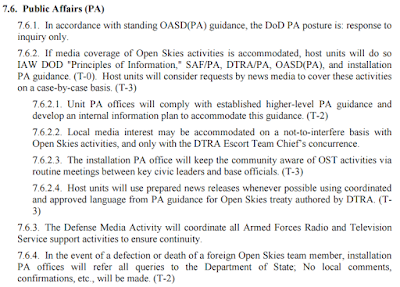Refer to previous posts I've written on the Open Skies Treaty for background; this post is just to get you the map with all the flight information available from FlightRadar24.
While elements of the media have been focused on the "outrage" of the "low-level" flight over the Pentagon, Camp David, and Trump's golf course, I've been laughing at the other obvious targets of their photography; including one of my favourite military targets; Site R. Several military bases, Navy facilities, Shipyards, Ammunition Depots, etc.. were photographed as well. Their altitude (~4000ft) suggests a digital panoramic camera is being used, but I don't have confirmation of that. The treaty mandates a maximum of 30cm resolution, which is less detailed than commercial satellite imagery, but the camera is certified as being tamper-proof, and the imagery can (is) shared among all 34+ signatories of the treaty.
Anyone telling you the Russians are using the Open Skies Treaty for purposes it wasn't intended to be used for has not read the treaty, or has ulterior motives. Don't believe the hype, look for yourself. Zoom in on the map below, look up your favourite East Coast military facilities. A reminder tho; military targets are not always military buildings or property. Tanks could be sitting in a rail yard, and could be just as valuable to check out year to year. General Dynamics or other defense contractors might be performing tests at a civilian owned property. Some very poorly informed people have even suggested the treaty has something to do with missiles. It does not. The treaty covers everything and anything they want it to cover; and that's how it works for our overflights of Russia as well.
Unfortunately, the "new" low altitude (by comparison w/ former ~10,000ft) flights makes it hard to triangulate the transponder using MLAT, so the flight route is spotty. Many of the targets are quite obvious. Also of note, the "swath" that the camera catches in the frame is large; I'm not sure how large with that camera at 4,000ft, but they do not need to be "over" something to get a good picture of it.
While elements of the media have been focused on the "outrage" of the "low-level" flight over the Pentagon, Camp David, and Trump's golf course, I've been laughing at the other obvious targets of their photography; including one of my favourite military targets; Site R. Several military bases, Navy facilities, Shipyards, Ammunition Depots, etc.. were photographed as well. Their altitude (~4000ft) suggests a digital panoramic camera is being used, but I don't have confirmation of that. The treaty mandates a maximum of 30cm resolution, which is less detailed than commercial satellite imagery, but the camera is certified as being tamper-proof, and the imagery can (is) shared among all 34+ signatories of the treaty.
Anyone telling you the Russians are using the Open Skies Treaty for purposes it wasn't intended to be used for has not read the treaty, or has ulterior motives. Don't believe the hype, look for yourself. Zoom in on the map below, look up your favourite East Coast military facilities. A reminder tho; military targets are not always military buildings or property. Tanks could be sitting in a rail yard, and could be just as valuable to check out year to year. General Dynamics or other defense contractors might be performing tests at a civilian owned property. Some very poorly informed people have even suggested the treaty has something to do with missiles. It does not. The treaty covers everything and anything they want it to cover; and that's how it works for our overflights of Russia as well.
Unfortunately, the "new" low altitude (by comparison w/ former ~10,000ft) flights makes it hard to triangulate the transponder using MLAT, so the flight route is spotty. Many of the targets are quite obvious. Also of note, the "swath" that the camera catches in the frame is large; I'm not sure how large with that camera at 4,000ft, but they do not need to be "over" something to get a good picture of it.



